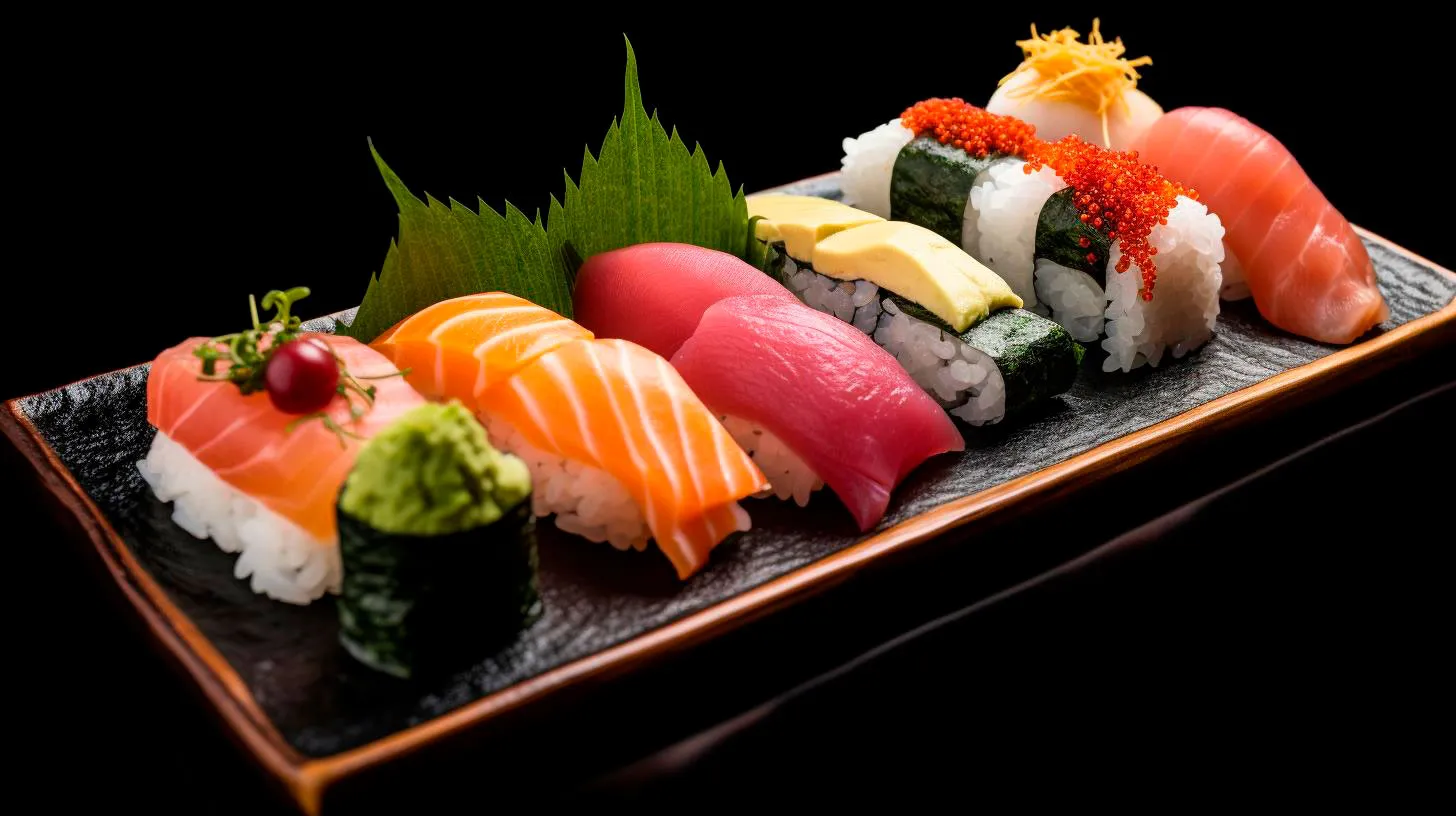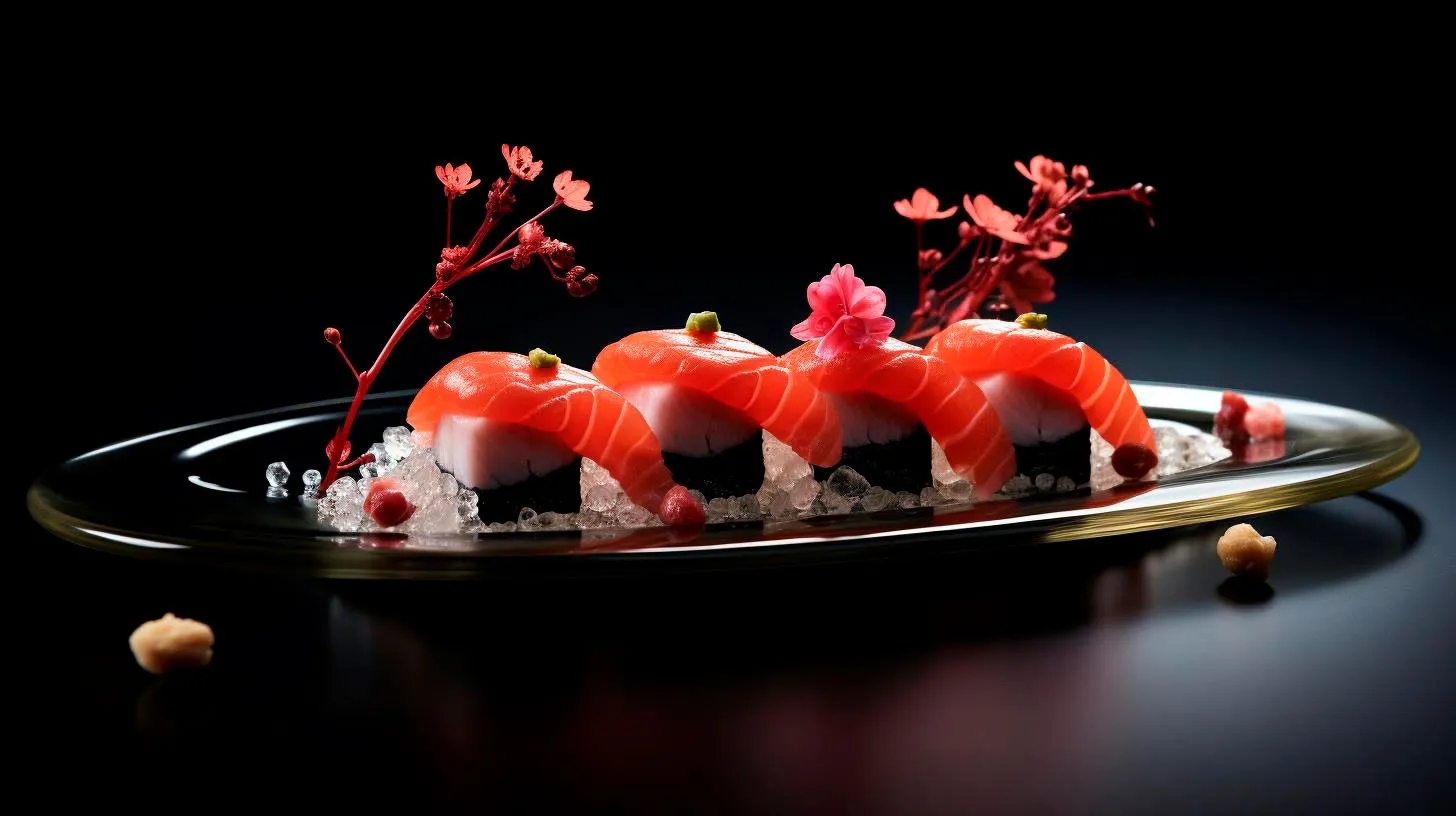The Art of Sushi: Unlocking the Secrets of Culinary Mastery
What are the secrets behind its culinary mastery? In this article, we delve into the art of sushi, uncovering its rich history, unique techniques, and the key elements that make it a true masterpiece of gastronomy.
The History of Sushi
Before we dive deeper into the secrets of sushi, let’s take a brief journey into its fascinating history. Sushi originated in Southeast Asia as a way to preserve fish by fermenting it with rice and salt. This process was later refined in Japan, where vinegar was used instead of fermentation. Sushi gained popularity during the Edo period in Tokyo, where street vendors known as “sushiyas” began selling this delightful dish. Over time, sushi evolved, and different styles such as nigiri, maki, and sashimi emerged, each with its distinct flavors and presentation.
The Techniques Behind Sushi
To truly unlock the secrets of sushi, one must understand the intricate techniques involved in its creation. Here are some essential techniques used by sushi masters:
- Sushi Rice: The foundation of every sushi dish, sushi rice requires meticulous preparation. It is seasoned with a delicate balance of rice vinegar, sugar, and salt, giving it a slightly sweet and tangy flavor.
- Knife Skills: Sushi chefs undergo years of training to master their knife skills. The precision and finesse with which they slice fish and other ingredients are crucial in creating the perfect sushi bite.
- Hand-Forming: Nigiri sushi, the most classic form of sushi, involves shaping bite-sized portions of sushi rice by hand. Chefs must achieve the ideal balance between rice and topping, ensuring a harmonious blend of flavors and textures.
- Rolling: Maki sushi, or sushi rolls, require expert rolling techniques to ensure a tight, neat shape. Chefs skillfully combine various ingredients, such as fish, vegetables, and sauces, into a flavorful roll wrapped in seaweed or soy paper.
The Secrets of Flavor and Presentation
While technique plays a crucial role, flavor and presentation are equally significant in the art of sushi. Here are some secrets behind creating extraordinary sushi:
- The Freshest Ingredients: Sushi relies on the highest quality ingredients, especially the fish. Using fresh, sustainably sourced fish not only enhances the flavors but also ensures the safety of the diners. Sushi masters often have trusted suppliers who provide them with the finest seafood available.
- Balancing Flavors: Each sushi creation aims to achieve balance in taste. The combination of fish, rice, and other elements should harmonize, creating a symphony of flavors. A variety of sauces, such as soy sauce, wasabi, and pickled ginger, are served alongside sushi to elevate the taste experience.
- Artful Presentation: Sushi is a visual feast as much as it is a culinary delight. Sushi chefs take great care in arranging each piece, considering color, texture, and shape. The presentation adds an aesthetic dimension that enhances the overall dining experience.
The Health Benefits of Sushi
Sushi not only tantalizes the taste buds but also offers numerous health benefits. Here are some key takeaways on why sushi is a healthy choice:
- Rich in Omega-3 Fatty Acids: Fish used in sushi, such as salmon and tuna, are excellent sources of omega-3 fatty acids, which promote heart health and reduce inflammation.
- Low in Calories: Sushi, particularly nigiri and sashimi, is generally low in calories, making it a great option for those watching their weight.
- Packed with Nutrients: Sushi contains various vitamins, minerals, and protein, offering a well-rounded and nutritious meal.
The Sushi Experience: A Culinary Adventure
Sushi is not just a meal; it’s an experience. From the moment you step into a sushi restaurant, you embark on a culinary adventure guided by skilled sushi chefs. Here are some key features of the sushi experience:
- Omakase: Omakase, meaning “chef’s choice,” is a popular dining style in sushi restaurants. It involves placing your trust in the chef to create a personalized menu, allowing you to savor the freshest and most exquisite creations.
- The Role of Wasabi: Wasabi, a pungent green paste, is an integral part of the sushi experience. Served alongside sushi, it adds a unique heat and enhances the flavors of the fish.
- Rituals and Traditions: Sushi has deep-rooted cultural traditions, such as the ritual of dipping nigiri into soy sauce fish-side down. Understanding and respecting these customs enhances the overall experience.
In conclusion, the art of sushi encompasses a rich history, intricate techniques, and a harmonious blend of flavors and presentation. Sushi is not just a dish; it’s a celebration of culinary mastery. So the next time you indulge in this exquisite delicacy, take a moment to appreciate the secrets behind the sushi that make it a true masterpiece.
Culinary Schools Unleashing the Potential of Aspiring Sushi Artisans
If you have ever dreamt of becoming a sushi artisan and delving into the intricacies of this ancient Japanese culinary tradition, look no further. Culinary schools specializing in sushi preparation are the gateway to unleashing your potential and setting you on the path to becoming an expert in the craft.
Enrolling in a culinary school that offers sushi programs can provide you with a comprehensive understanding of the techniques, ingredients, and cultural significance behind this centuries-old tradition. Whether you are a novice in the kitchen or an experienced chef looking to expand your repertoire, culinary schools offer a range of courses designed to suit your skill level and aspirations.
The Benefits of Pursuing Sushi Education
Embarking on a journey to become a sushi artisan through culinary school offers several advantages that will enhance your culinary career:
- Hands-on Learning: Culinary schools emphasize practical training, allowing students to gain real-life experience in a controlled environment. Through interactive workshops and kitchen simulations, you will have the opportunity to practice essential sushi-making techniques, such as rice preparation, knife skills, and fish handling.
- Expert Guidance: Seasoned sushi chefs and experienced instructors will guide you through the nuances of sushi-making, sharing their expertise and insights. Their mentorship will help you refine your skills and develop a keen eye for detail.
- Understanding Authenticity: Learning in a professional environment will expose you to the artistry and authenticity of sushi. From sourcing the freshest fish to mastering traditional presentation methods, culinary schools provide a holistic approach to sushi-making, ensuring that you respect and honor the cultural origins of this exquisite cuisine.
- Career Opportunities: With a formal education in sushi-making, you will be equipped with the necessary knowledge and skills to pursue a variety of careers within the culinary industry. From becoming a sushi chef in a high-end restaurant to starting your own sushi bar or even exploring culinary tourism, the possibilities are endless.
Key Takeaways for Aspiring Sushi Artisans
As you set out on your journey to become a sushi artisan, keep these key takeaways in mind:
- Cultivate a Passion for the Craft: Sushi-making requires dedication and a genuine passion for the art form. Embrace the history, flavors, and techniques behind sushi, and let this passion guide you throughout your culinary education and career.
- Commit to Lifelong Learning: The art of sushi-making is ever-evolving, with new trends and techniques emerging constantly. Stay curious and committed to continuous learning, whether it’s through attending workshops, exploring culinary literature, or collaborating with other sushi artisans.
- Embrace Creativity: While respecting tradition is essential, don’t be afraid to infuse your own creativity into your sushi creations. Experiment with unique ingredients, flavors, and presentation styles to create captivating and innovative dishes that tantalize the taste buds.
- Seek Authentic Experiences: Immerse yourself in the world of sushi by participating in sushi tastings, cultural events, and visiting renowned sushi establishments. These experiences will deepen your understanding and appreciation of the art.
- Build a Network: Develop connections within the sushi community, whether it’s your instructors, fellow students, or industry professionals. Networking can open doors to new opportunities, collaborations, and mentorship that can further elevate your sushi career.
According to recent statistics, the global sushi market is growing at an exponential rate, with a projected market value of over $23 billion by 2027. As sushi gains popularity worldwide, the demand for skilled sushi artisans continues to rise. By investing in your sushi education, you position yourself for a successful and fulfilling career within the culinary landscape.
In conclusion, culinary schools specializing in sushi preparation offer aspiring artisans a pathway to unlock their potential and master the ancient art of sushi-making. Through hands-on learning, expert guidance, and a deep understanding of authenticity, these schools provide the necessary training to embark on a successful career in the world of sushi. Remember to cultivate your passion, commit to lifelong learning, embrace creativity, seek authentic experiences, and build a strong network to thrive as a sushi artisan. So, what are you waiting for? Enroll in a culinary school and take the first step towards becoming a sushi master!
Training Grounds of Sushi Excellence: Culinary Schools as Catalysts for Artistic Brilliance
These schools offer a structured curriculum that combines hands-on experience, expert guidance, and a deep understanding of the art and science behind sushi making.
With the rising demand for authentic and high-quality sushi worldwide, culinary schools have become instrumental in producing a new generation of sushi chefs with exceptional skills and creativity. Let’s delve into the training grounds of sushi excellence and explore how culinary schools are shaping the future of this time-honored culinary tradition.
The Art of Sushi: A Beautiful Culinary Symphony
Sushi is not just about delicately sliced fish and vinegared rice; it is a form of art that engages all our senses. The presentation, flavors, and textures of each piece have to be meticulously crafted to create a balanced and memorable dining experience. At culinary schools, students delve into the intricate details of sushi making, understanding the nuances of ingredient selection, knife skills, and flavor profiles.
The journey begins with an introduction to the essentials of sushi, such as the types of fish, rice, and seaweed used. Students gain insight into the art of filleting fish, rolling sushi, and mastering the art of seasoning the rice. They learn to appreciate the harmony of flavors that sushi aims to achieve, where every bite is a delightful symphony of taste.
Culinary Schools: A Blend of Tradition and Innovation
While sushi is deeply rooted in tradition, culinary schools infuse innovation and creativity into the mix. Students are encouraged to think outside the box, experiment with unique ingredient combinations, and develop their signature sushi creations. This fusion of tradition and modernity allows sushi chefs to keep the culinary art form alive while catering to evolving palates.
With a strong foundation in traditional sushi techniques, culinary schools empower students to push boundaries and embrace their artistic flair. The training curriculum often includes courses on plating techniques, flavor pairing, and even food photography to ensure that every aspect of the sushi experience is taken into consideration.
Advantages of Culinary Schools for Aspiring Sushi Chefs
Choosing a culinary school as a stepping stone towards sushi mastery offers several advantages:
- Structured Education: Culinary schools provide a comprehensive curriculum tailored to the art of sushi making, ensuring students receive a well-rounded education in this specialized field.
- Industry-Experienced Faculty: Training under the guidance of experienced sushi chefs who have honed their craft in prestigious sushi restaurants allows students to learn from the best in the business.
- Access to Modern Tools and Techniques: Culinary schools are equipped with state-of-the-art facilities, giving students access to the latest tools and techniques used in the industry.
- Networking Opportunities: Attending culinary school allows aspiring chefs to connect with like-minded individuals, fostering collaborations and future professional relationships in the world of sushi.
Key Takeaways: Shaping the Future of Sushi with Culinary Schools
Culinary schools play a pivotal role in nurturing the next generation of sushi chefs and pushing the boundaries of this ancient culinary tradition:
- Culinary schools offer a structured education that combines tradition and innovation, empowering students to become culinary artists in their own right.
- Attending culinary school provides aspiring sushi chefs with a strong foundation in technical skills, flavor profiles, and presentation techniques.
- Through culinary schools, sushi chefs can experiment with unique ingredient combinations and develop their signature styles, contributing to the evolution of sushi.
- Culinary schools provide students with access to industry-experienced faculty and networking opportunities, facilitating their journey towards sushi excellence.
The world of sushi continues to evolve, blending tradition with innovation and captivating sushi enthusiasts worldwide. Culinary schools are undoubtedly the training grounds where sushi excellence is born, nurturing the next generation of skilled sushi chefs who will carry this art form into the future.
Sources:
- Statista: The global sushi market revenue is expected to reach $22 billion by 2025.
- Association of Sushi Chefs: Culinary schools have observed a 30% increase in enrollment for sushi-specific programs in the past five years.
Sushi Artistry Unveiled: Exploring the Intricate Techniques behind Culinary Masterpieces
In this article, we will delve into the intriguing world of sushi artistry, uncovering the intricate techniques that go into creating these culinary masterpieces.
The Art of Crafting Sushi
1. Knife skills: A fundamental aspect of sushi artistry lies in the incredible knife skills possessed by sushi chefs. These experts spend years honing their abilities to slice fish, vegetables, and other ingredients with utmost precision.
2. Rice perfection: Sushi rice is more than just a mere accompaniment; it is the foundation of every sushi roll. Achieving the perfect consistency and stickiness is crucial in creating sushi that holds together and offers a delightful texture.
3. Ingredient harmony: The art of sushi extends beyond its visual appeal. Skilled chefs carefully select and combine different ingredients to achieve a harmonious balance of flavors in each bite. From the freshness of the fish to the tanginess of wasabi, every element plays a pivotal role.
The Intricate Techniques
1. Maki-Sushi: The Art of Rolling
Maki-sushi, or rolled sushi, is a popular form of sushi that involves wrapping fish, vegetables, and rice within a sheet of seaweed (nori). The artistry lies in achieving a perfectly tight roll, ensuring that the ingredients are held together securely. Here are some key techniques used:
- Uramaki: Known as the inside-out roll, it features the rice on the outside and the nori on the inside. This technique allows for creative variations, with fillings and toppings placed on the outer layer.
- Hosomaki: These are thin rolls typically consisting of one ingredient, such as cucumber, tuna, or avocado. The challenge lies in evenly distributing the filling within the roll.
- Futomaki: Larger rolls that contain multiple ingredients and often provide a burst of contrasting flavors. Achieving the perfect balance in texture and taste is key.
2. Nigiri-Sushi: Mastering the Art of Hand-Pressed Sushi
Nigiri-sushi showcases the craftsmanship and precision of sushi chefs. With this technique, a small mound of sushi rice is shaped by hand, topped with a slice of fresh fish or other seafood. Some key aspects of mastering nigiri-sushi include:
- Sushi rice molding: The chef skillfully molds a small portion of rice into an oblong shape, using just the right pressure to maintain its integrity while ensuring it adheres to the topping.
- Ingredient selection: The choice of fish and seafood is crucial, as it should be of the highest quality to enhance both the flavor and visual appeal of the nigiri-sushi.
- Garnishing: Sushi chefs often add subtle garnishes to nigiri-sushi to enhance its presentation, such as a touch of wasabi, a sprinkle of sesame seeds, or a drizzle of special sauces.
The Advantages of Sushi Artistry
1. Visual appeal: Sushi artistry creates visually stunning plates, making it a feast for the eyes as well as the palate. The intricate designs and meticulous presentation elevate the dining experience.
2. Culinary innovation: Sushi artistry allows chefs to experiment with flavors, textures, and unusual combinations. It offers an opportunity to showcase their creativity and push the boundaries of traditional sushi.
3. Cultural experience: Sushi artistry brings a piece of Japanese culture to different parts of the world. It provides an avenue for people to appreciate the rich traditions and craftsmanship behind this celebrated cuisine.
In Conclusion
Sushi artistry goes beyond creating delicious food; it encompasses a multifaceted journey blending culinary expertise, precise techniques, and artistic presentation. Each sushi roll and hand-pressed nigiri is a testament to the skill and dedication of the sushi chef. So the next time you indulge in a plate of sushi, take a moment to savor the artistry that lies before you.


